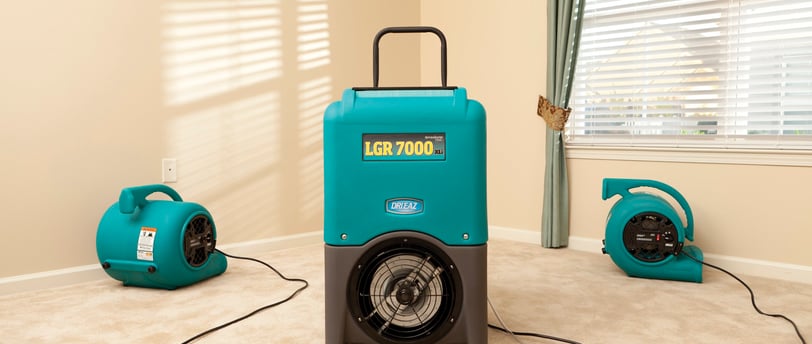Harnessing the Power of Dehumidification in Water Mitigation: A Restoration Specialist's Guide
Dehumidification in Water Mitigation
11/29/20233 min read


Introduction:
Water damage is a formidable adversary that, if left unchecked, can lead to a host of issues, including structural damage and mold growth. In the realm of water mitigation, dehumidification emerges as a powerful tool to combat the aftermath of water intrusion. In this comprehensive guide, we will delve into the intricacies of dehumidification in water mitigation, exploring its importance, methods, and the pivotal role it plays in restoring spaces to their pre-loss condition.
Section 1: Understanding the Impact of Water Damage
1.1 The Stealthy Invader
Water damage can be insidious, infiltrating hidden spaces and wreaking havoc on structural elements. Its effects are not always immediately apparent, making thorough assessment and mitigation crucial for preventing long-term damage.
1.2 The Role of Moisture in Mold Growth
Moisture serves as the catalyst for mold growth. In as little as 24-48 hours, mold spores can take root and flourish in damp environments, posing health risks and compounding the challenges of restoration.
Section 2: The Importance of Dehumidification in Water Mitigation
2.1 Swift Evaporation and Drying
Dehumidification expedites the drying process by removing excess moisture from the air. This, in turn, accelerates evaporation, a fundamental step in mitigating water damage.
2.2 Mold Prevention
By reducing humidity levels, dehumidifiers play a pivotal role in mold prevention. Mold thrives in high humidity environments, and effective dehumidification creates an inhospitable climate for its growth.
Section 3: Types of Dehumidifiers
3.1 Refrigerant Dehumidifiers
Commonly used in water mitigation, refrigerant dehumidifiers operate by cooling air to condense moisture, which is then collected in a reservoir. These units are effective in a variety of temperature ranges.
3.2 Desiccant Dehumidifiers
Desiccant dehumidifiers use moisture-absorbing materials to extract water vapor from the air. Ideal for low humidity conditions, they offer a powerful solution for thorough drying.
3.3 Low-Grain Refrigerant Dehumidifiers
Low-grain refrigerant dehumidifiers, also known as LGR dehumidifiers, are advanced units designed to handle large quantities of moisture efficiently. They are particularly effective in extreme conditions and after major water events.
Section 4: Calculating Dehumidification Requirements
4.1 Understanding Specific Humidity
Specific humidity is a measure of the actual amount of moisture in the air. Calculating specific humidity is crucial for determining the appropriate capacity and duration of dehumidification required for effective water mitigation.
4.2 Factors Influencing Dehumidification Needs
Several factors, including the extent of water damage, ambient temperature, and the type of materials affected, influence dehumidification requirements. A thorough assessment is necessary for tailored dehumidification strategies.
Section 5: Placement and Utilization of Dehumidifiers
5.1 Strategic Placement
Strategically placing dehumidifiers is vital for optimal results. Positioning units in areas with high humidity and focusing on the affected spaces ensures targeted and efficient moisture removal.
5.2 Adequate Ventilation
Proper ventilation complements dehumidification efforts. It expedites the removal of moist air and introduces drier air, facilitating a more effective drying process.
Section 6: Monitoring and Adjusting Dehumidification
6.1 Real-Time Monitoring
Utilizing moisture meters and hygrometers allows restoration specialists to monitor humidity levels in real-time. This data-driven approach enables adjustments to the dehumidification strategy as needed.
6.2 Adjusting Dehumidifier Settings
Dehumidifiers often come equipped with adjustable settings. Professionals can fine-tune parameters such as fan speed and humidity set points to optimize performance based on the evolving conditions of the water mitigation project.
Section 7: Dealing with Hidden Moisture
7.1 The Challenge of Hidden Pockets
Water can seep into hidden pockets, such as wall cavities or subflooring, presenting a challenge for effective dehumidification. Restoration specialists employ advanced techniques, such as infrared thermography, to identify and address hidden moisture.
7.2 Injectidry Systems
Injectidry systems use targeted airflow to reach concealed moisture. This method is particularly effective for drying within wall cavities and other confined spaces.
Section 8: Post-Dehumidification Assessments
8.1 Verifying Dryness
Thoroughly assessing the dryness of affected materials is essential before concluding the water mitigation process. Moisture meters and visual inspections are employed to ensure that optimal dryness is achieved.
8.2 Addressing Lingering Odors
In some cases, water damage can lead to persistent odors. Restoration specialists may utilize air scrubbers or other odor elimination techniques to ensure the space is not only dry but also free from unpleasant smells.
Section 9: Professional Expertise and Training
9.1 Certified Water Damage Restoration Specialists
Engaging certified water damage restoration specialists ensures that dehumidification strategies are applied with precision. Specialists undergo rigorous training to stay abreast of the latest technologies and techniques in the field.
9.2 Collaborative Restoration Plans
Effective water mitigation involves collaboration between various restoration components. Professionals work seamlessly to integrate dehumidification into comprehensive restoration plans tailored to the specific needs of each project.
Conclusion:
Dehumidification stands as a linchpin in the water mitigation process, providing a potent defense against the lingering effects of water damage. Through an understanding of its importance, the types of dehumidifiers available, and strategic utilization, restoration specialists harness the power of dehumidification to restore spaces to their pre-loss condition efficiently. As technology continues to advance, so too do the tools and methods at the disposal of restoration specialists, ensuring that dehumidification remains a cornerstone in the battle against the aftermath of water intrusion.
A-Z Dryout
3260 N Hayden Rd STE 210 Scottsdale. Arizona 85251
(480) 617-0978
azdryout@gmail.com
